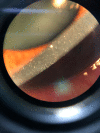Dieffenbachia-Induced Transient Crystalline Keratopathy: A Case Report and Review of Previously Reported Cases
- PMID: 35165597
- PMCID: PMC8831483
- DOI: 10.7759/cureus.21146
Dieffenbachia-Induced Transient Crystalline Keratopathy: A Case Report and Review of Previously Reported Cases
Abstract
We report a case of transient crystalline keratopathy induced by contact with Dieffenbachia plant sap and review previous reports on plant-induced crystalline keratopathy. A 27-year-old man with underlying diabetes mellitus presented with ocular pain, redness, and tearing after Dieffenbachia plant sap accidentally entered his right eye while he had been cutting the grass one day prior to presentation. The visual acuity of his right eye was 6/9. His conjunctiva was injected with an epithelial defect over the inferior conjunctiva. There were fine needle-like oxalate crystals in the epithelial and stromal layer of the cornea inferiorly. He was treated with topical dexamethasone and levofloxacin. The crystals disappeared from the cornea when he was reviewed one month later. He maintained good visual acuity, and no corneal opacity was noted. In conclusion, patients with crystalline keratopathy after exposure to Dieffenbachia plant sap can have a full recovery without sequelae after supportive treatment. Eliciting the history from patients regarding the type of plant involved is imperative. Ophthalmologists should be aware of the possibility of crystalline keratopathy developing, even though most patients retain good vision.
Keywords: araceae; calcium oxalate; cornea; corneal diseases; plant extracts.
Copyright © 2022, Chong et al.
Conflict of interest statement
The authors have declared that no competing interests exist.
Figures



References
-
- Dieffenbachia plant poisoning cases and effects on human health. Ünlü Ü, Kocabaş A. Ant J Bot. 2020;4:65–68.
-
- Dieffenbachia: benefits vs risks of a household ornamental plant-a review. Syamjith P, Vinod KR, Vipuldas MK, Venkatesh R, Sindhu TJ, Johncy NJ. https://wjpr.s3.ap-south-1.amazonaws.com/article_issue/1538211596.pdf World J Pharm Res. 2018;7:598–604.
-
- Dieffenbachia: uses, abuses and toxic constituents: a review. Arditti J, Rodriguez E. J Ethnopharmacol. 1982;5:293–302. - PubMed
Publication types
LinkOut - more resources
Full Text Sources
Miscellaneous
